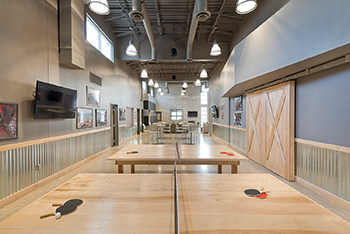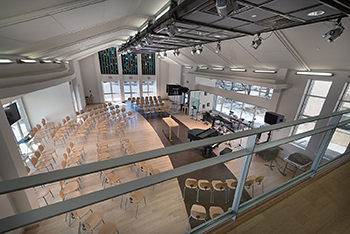
From exterior / interior approaches; to engaging spaces for children, youth and Millennials; to community engagement by design — and more — the church design trends we’re seeing today aren’t the same as they were 10, or even five, years ago.
Here, Scott A. Nelson, AIA, LEED AP BD+C, explains.
Let’s begin with church exteriors, in general. What design trends are you observing at the moment?
Nelson: Exterior design is continuing to be defined by the church “DNA” in that their facilities help define an image that further speaks to their ministry objectives. Your facilities are an extension of your “brand” and thus often create a “first impression.”
For some churches who are ministering to the non-churched or de-churched, their focus is on creating an exterior image that is primarily “inviting and welcoming” but not necessarily overt in church symbolism.
Other churches make it a priority to have their facilities incorporate church symbiology, whether through a simple cross or elegant steeple and stained glass.

Photographer: Keith Talley
How do these emerging trends compare to 5-10 years ago?
Nelson: Several of our current church clients are seeking to maximize their ministry space by using outdoor environments. These spaces often provide connection space for church members, including covered plazas with outdoor seating areas, water features, children’s play areas, covered sports courts and ballfields.
These outdoor spaces serve also serve as a draw to the community whereby the church can host a variety of activities, including “movie night on the lawn,” food trucks around the plaza, as well as special performances in the amphitheater venue.
Regarding interior spaces, generally, what design trends are emerging of late? What ministry objectives are driving

these design trends?
Nelson: Hospitality is top of mind for many churches as they seek to create a great first impression for their guests and members. Two areas of focus are the “Welcome Desk / Welcome Area” and “Connection Central.”
To remove apprehension from first-time guests, Welcome Desks or Welcome Areas are being strategically located so that they maintain high visibility from the entry doors. While some churches use a desk where staff / volunteers stand behind the counter and provide assistance to guests — similar to a Starbucks — other churches are using an “Apple Store – Genius Bar” concept where staff / volunteers engage with guest in a defined “area” around bar-height bistro tables.
The other trend that we’re seeing is the development of a “Connection Central,” which functions similarly to a church parlor from days of old. These spaces are often located in close proximity to the worship center and adjacent to the main lobby areas. Whether a room unto itself or simply a defined space, these environments are  transparent / open / inviting, but also allow for private conversations. This is a place that allows members and guests to meet with the pastor and staff before and after services, such that you can seek to learn more about the church, seek counsel, or share prayer requests and praises.
transparent / open / inviting, but also allow for private conversations. This is a place that allows members and guests to meet with the pastor and staff before and after services, such that you can seek to learn more about the church, seek counsel, or share prayer requests and praises.
How do these emerging trends compare to 5-10 years ago?
Nelson: Churches are investing in hospitality / connection spaces beyond traditional worship or education spaces. Space planning involves more than just seats in the worship center and classrooms for kids / students / adults. Churches are seeing the importance to create space on campus for people to connect outside of the worship center and classroom.

Let’s talk about the design trends that are resonating among children in the church, and why.
Nelson: Churches are redefining their education spaces based upon the learning modalities of today’s students as often seen by the new schools that are being built in the community. Schools have recognized that today’s students learn differently than their parents’ generation, which assumed students will all learn the same thing, at the same time, from the same person, in the same way, in the same place, for several hours each day.
Churches are beginning to implement 21st Century Design standards for learning environments that use a combination of spaces, including classrooms, learning studios, flex spaces, teaching spaces and moveable furniture that caters to each individual learning style, including auditory, visual and kinesthetic. The variety of spaces allow for teachers to better address each student’s unique learning modalities (i.e., individual, peer tutoring, team collaboration, lecture format, etc.).
What about youth-centric design trends?
Nelson: Most Student Ministries are choosing to create more relational connection space and less entertainment/game room space. Today’s teen is consumed with “screens,” be it an iPhone, computer or TV. As such, churches are seeking to provide space that allows for people to gather and connect “face to face.”
Student spaces have more places for informal seating groups (think Starbucks coffee) along with relational game areas (i.e., ping pong, pool table, foosball, etc.).
And Millennials?
Nelson: Similar to Youth, we see Millennial Ministries are focused on creating relational spaces that allow them to connect with one another. We see less concern about architectural styling (i.e., traditional or modern) and more focus on providing spaces that engage and connect with each other and the community.
Do design trends differ by church size? (For example, are the trends you’re seeing in mid-size churches different than the trends you’re observing in large churches?)
Nelson: We’re seeing a growing trend for larger churches to reinvest in adult education space. Sunday school, bible fellowship, small groups, LIFE groups, home groups … call it what you will, but churches are looking for ways to engage their people beyond the worship service on Sundays.

A few years ago, education space (for adults) seemed to fall out of favor across churches. For some, this was a strategic ministry decision; for others, it was a result of a lack of funds / space as churches relocated to new sites and chose not to build these spaces, as they were deemed to only be used for “one hour a week.” As with most things, history appears to be repeating itself as more churches are finding a need for adult education space on campus; however, it’s not your typical “Sunday school” space. More than just a classroom, churches are investing in training center and learning institute-type spaces that provide a new type of educational offering ranging from topical classes to seminary prep / replacement for future ministry leaders.
Are churches designing their facilities to engage the surrounding community more in recent years? If so, what ‘shapes’ is that trend taking?
Nelson: Absolutely, we see a growing trend in churches looking to invest in outdoor spaces as a way to engage their community. From outdoor plazas, to playgrounds, to ballfields and amphitheaters, outdoor spaces can provide high-impact community space for a relatively low cost.
Also, we’re seeing churches make the strategic decision to allow their buildings to be shaped not by church programming needs, but rather by community needs.
For example, weekday preschool classes might provide specific space driver needs rather than Sunday morning class needs for children.
Large worship centers (1,500+ seats) are using “flat floors” in lieu of sloped seating so that these venues can transition throughout week to host a variety of events (i.e., round tables, recreation events, etc.) for community groups (i.e., School District, PTA, Rotary Clubs, etc.) and then return to assembly space on the weekend.
When it comes to multisite campus design, what design trends are you noticing unique to these facilities?
Nelson: Consistency of branding seems to be a common design discussion such that the platform and stage design “speaks the same language” across all campuses. This can be as simple as a consistency in the stage prop design and band member location.
For others, this includes standardizing the materials and paint color choices for the front proscenium so that through the “camera lens,” there’s no distinction between campuses.
Let’s talk about adaptive reuse. Is that still a big trend, or are churches moving away from that in recent years?
Nelson: Adaptive reuse often provides the most space at the least initial cost for a church. As such, this fits the financial goals for some churches instead of buying land and building new. No two adaptive reuse properties will be the same, so it’s important for churches to invest in Facility Assessments before acquiring the properties so that they can better understand “what” they’re buying with existing facilities. Facility Assessments should include Systems & Materials (deferred maintenance), Accessibility, Security / Safety, Cost of Ownership and Fit for Program Adequacy (Worship / Education / Parking).
How prevalent is green design among church clients / projects today compared to 5-10 years ago?
Nelson: Churches desire to implement green design and sustainable building practices; however, they often stop short of seeking third-party certification as there’s no tax advantage for this additional cost which is often sought for commercial buildings.
Is technology a big consideration in designing and building church facilities these days? If so, what forms is that taking?
Nelson: Most notably, our worship environments tend be the largest consumer for technology in the church. From sound systems, to video projection, to HD broadcast cameras, to stage lighting, churches are using the latest technologies to create a user experience that’s on par with those of any sporting event or performing arts / concert venue. As attention spans decline and “other” activities spill into Sundays, churches are seeking technology to create environments that engage the senses and communicate in ways that people have become accustomed to, be it a sporting event, concert or the pastor’s sermon.
The use of technology in the church has become less about creating an “entertainment show,” but rather we see churches use technology to more effectively communicate the message, be it a worship song or sermon.
Scott A. Nelson, AIA, LEED AP BD+C is a Principal and the Frisco, TX office manager for Parkhill, Smith & Cooper. He brings more than 13 years of design experience in religious and educational facilities.
With a passion for helping churches succeed, Nelson serves as a ministry-partner/problem-solver with many of the fastest-growing, top-attended churches and private Christian schools across America.


